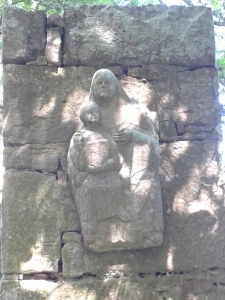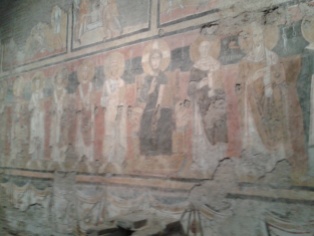This summer I spent a few days in Pluscarden Abbey in Moray, the only medieval monastery in the UK which is still being used for its original purpose.
I simply didn’t know what to expect, beyond the fact that the womens’ guesthouse was in an isolated spot some distance from the main abbey and that I would have to bring my own food.

Arrival
A taxi from Elgin was the only way to get there without a private car although I later realised that there is a pilgrim walking path which I would try to take next time. The taxi left the town and was soon travelling through wood and farmland along winding single-track road.
The driver, perhaps a little worried about leaving me outside the abbey when there was no-one in sight, set me down by the front entrance and rang the bell. A sleepy-looking monk appeared, muttered something about ‘meridian’ (which I later learnt was afternoon nap), and gave me a key to the women’s guesthouse.
The guesthouse was at the end of a track beside a large field. Each of the rooms bore the name of a saint. I chose St Clare, because she had been a friend of St Francis of Assisi, dumped my bags on the floor and burst into tears with relief that I had got here and could finally rest.
The last year has been difficult. When faced with challenges, I have learnt that I simply can’t operate without prayer. However, sometimes I don’t pray or don’t make it a priority. The week before going to Pluscarden had been particularly busy trying to finish things before I left, some of which could have waited. By the time I reached the Abbey, my nerves were so jangled that I couldn’t have gone on another day.
My first prayer was that my own state of un-peace would not disturb this peaceful place.
Awe
Bells rang out to announce each office. On first seeing the medieval church with its grey, stone walls, gothic arches and stained glass windows, I simply felt awe. The daily Bible readings during Mass are read out in English. Apart from that, everything else is in Latin although there are leaflets for each Office with the Psalms both in Latin and in English.
The Psalms are sung in Gregorian chant which after a while seemed to get inside me and go through my mind like the rhythm of prayer, even when I wasn’t in the church.
More than the building itself, I was impressed by the monks’ faith. Apart from producing their own food and some products, such as honey, to sell, they don’t have any way to earn money. And yet they open up their home to guests without charging any fee although donations are gratefully accepted. That takes faith.
The monastery was founded in 1230 and a community lived there for over 300 years until Scotland separated from the Catholic church in 1560 when it fell into private hands. By the twentieth century, it was a roofless ruin. However, the current owner, the Marquis of Bute, offered it to the Benedictine Community in Prinknash, England.
In 1948, five monks went north to live in the ruined abbey. Somehow, while spending five hours a day praying the Divine Office, these monks oversaw the restoration of the Abbey. As one monk said to me, ‘If they hadn’t prayed eight times a day, very little would have got done.’
Overwhelmed
In Pluscarden, everything revolves around prayer. On the website, the Prior says, ‘We came to the monastery to pray: we’re not in a hurry; we have nothing better to do.’
To say I was completely overwhelmed by the formality and beauty of the prayers and the solemnity of the Latin Mass would be an understatement.
Just as they had in Rome, my Protestant criticisms rose again. Was I really part of a church which spoke Latin, and made liberal use of the incense burner and holy water shaker? Why did the church expect its monks to pray seven times a day and rise once in the night for prayer? Wasn’t that a bit excessive? And while I was at it, I might as well have a go at the rules governing Catholic laypeople, the Sundays and the Holy Days of Obligation. My Protestant voice told me to pick and choose, take the bits I was comfortable with and leave the rest, whilst my agnostic voice told me to step back, view it from a distance without getting too involved or committed.
I didn’t expect to be assailed by doubts in a monastery, but that’s sometimes what happens when you take time to be still and another layer of doubt and mistrust is uncovered.
Refuge

I overcame my doubts (with some help!)
During the Latin Mass, I listened for the bell and the words of the consecration as the priest lifted up the bread and wine, and I felt more peaceful. Christ was here. God is transcendent, but also immanent.
Compline was my favourite office, the last of the day, when we sat in the candlelit church for a few moments silence before an act of contrition and a Psalm. It ended with an anthem to the Virgin Mary. As a former Protestant, I struggle with devotion to Mary. How much is too much? How can focussing on Mary bring me closer to her son. However, sitting in a medieval chapel in the evening listening to the monks sing Salve Regina (Hail Holy Queen) sent goosebumps up my spine and left me with a sense of peace.
During my time in Pluscarden, I often thought of ‘Seven Storey Mountain’ by Thomas Merton, a convert and Cistercian monk. He describes saying the Rosary with the other monks as they returned from the fields and says, ‘Who knows what grace overflows into the world from that valley, from those rosaries, in the evenings when the monks are swinging home from work!’
I felt gratitude that there was such a place as Pluscarden. Surely some of these prayers must overflow, not just to guests, but to the wider world. It was also a place where I began to learn about recognising grace in the small things in life.
Take away
What will I take away? Calmed nerves and an increased feeling of peace, but that won’t last unless I continue in prayer. The monks’ witness is strong. I’ve seen what can happen if you make prayer a priority: medieval ruins can be rebuilt and become a refuge for Catholics, other Christians and people of other faiths or none at all.
I’ll also bring back an appreciation of the Divine Office, the challenge and delight of praying the Psalms and the words of the Prior when he paraphrased St John of the Cross and said that our mission as Christians is to ‘have faith where there is no faith, hope where there is no hope and love where there is no love.’














